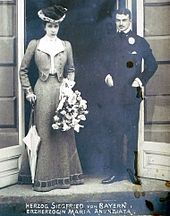Siegfried in Bavaria

Siegfried August Maximilian Maria in Bavaria (born July 10, 1876 in Bamberg , † March 12, 1952 in Munich ) was a Wittelsbach prince from the sidelines of the dukes in Bavaria . Due to a riding accident in 1899, he suffered permanent mental impairment.
Life
Before the accident
Prince Siegfried was the oldest of three sons of Duke Max Emanuel in Bavaria and his wife Amalie of Saxe-Coburg and Gotha . He was born in Bamberg, because his father served there as an officer in the 1st Bavarian Uhlan Regiment , later this advanced to major general and head of the military riding school in Munich .
The family had their seat at Biederstein Castle near Munich and was unofficially called "Biedersteiner Line" after this possession. The father Max Emanuel died surprisingly on June 12, 1893 in Feldafing of a gastric bleeding caused by an ulcer. The mother suffered greatly from her husband's sudden death. A few months later, Prince Siegfried fell ill with scarlet fever . His mother took care of him, became seriously ill herself and died on May 6, 1894, of peritonitis.
The three children had become orphans within less than a year. The uncle, Duke Carl Theodor in Bavaria and his wife Marie José of Portugal , took care of the orphaned boys and even intended to take them fully into their family, which their grandmother Clementine d'Orléans refused. She wanted to keep the children their own family line and the seat at Biederstein Castle. Therefore, the lady-in-waiting of the late Duchess Amalie, Countess Maria Fugger-Glött (1859-1934) took over the education, supported by Duke Carl Theodor and Marie José, who even temporarily moved to Biederstein.
When Prince Siegfried was declared of legal age in 1894, he received Baron Max von Redwitz , son of the poet Oskar von Redwitz , as an adjutant , who at the same time headed the Biederstein castle household as court master and had been in the service of his parents since 1889.
Siegfried in Bavaria was appointed Grand Prior of the Order of Knights of St. George , where he performed representative tasks, he was also a Knight of Hubert and joined the Historical Association of Upper Bavaria. A passionate rider, like his father, he had the lake meadow of Schloss Biederstein converted into a training ground with jumping obstacles. The Wittelsbacher soon became known in Riem and on other racing courses. On June 23, 1899, he emerged victorious from the 1st race of the Munich-Riem riding and jumping tournament . In the second race his horse overturned and the young duke fell on his head, seriously injuring himself and remaining unconscious for several days. This should completely change his life.
After the accident
This is because permanent brain damage and mental disorders set in. In 1902 Siegfried became engaged to Archduchess Maria Annunziata of Austria in Bavaria and in the summer of that year visited her and her mother Marie Therese of Portugal , the bride's grandmother, Adelheid von Löwenstein-Wertheim-Rosenberg , exiled Queen of Portugal. She had become a Benedictine widow in the monastery of St. Cäcile, near Cowes , on the English island of Wight .
Shortly after the trip to England, however, the engagement was canceled again by mutual agreement, as Duke Siegfried showed clear behavioral disorders, the causes of which could be traced back to the riding accident.
The disease was getting worse. Siegfried von Bayern suffered from ideas of persecution and acoustic hallucinations. He also imagined that people would fix him in public, laugh at him and despise him. For fear of murder, the Duke always carried a loaded revolver with him and sometimes shot it randomly out of the castle windows. He also announced his suicide several times. He was therefore transferred to the Neufriedenheim sanatorium , where he spent most of the rest of his life under medical supervision.
On May 29, 1918, the Wittelsbacher was formally incapacitated and Justice Minister Ferdinand von Miltner was appointed as guardian. The younger brothers Christoph in Bavaria (1879–1963) and Luitpold in Bavaria (1890–1973) also took care of him until he died in Munich in 1952.
Duke Siegfried found his final resting place in the outer Wittelsbach crypt of the parish church of St. Quirinus (former monastery) at Tegernsee .
literature
- Norbert Nemec: Archduchess Maria Annunziata (1876–1961): The unknown niece of Emperor Franz Joseph I , Böhlau Verlag Vienna, 2010, ISBN 3205784561 , pp. 92–116; Scan from the source
- Heinz Häfner: A king is eliminated: Ludwig II of Bavaria , CH Beck Verlag, 2011, pp. 213–221, ISBN 3406617859 ; Scans from the source
Individual evidence
- ↑ On the life data, see children of person 10 on this page ( Memento from February 24, 2013 in the Internet Archive )
- ↑ Website with epitaph of Countess Maria Fugger-Glött
- ^ Friedrich Wolf: François de Cuvilliés , volumes 87-89, volume 89 of: Oberbayerisches Archiv , 1967, pages 40 and 41; Section scans from the source
- ↑ Website of the crypt, with mention of Duke Siegfried ( Memento from July 8, 2017 in the Internet Archive )
Web links
| personal data | |
|---|---|
| SURNAME | Bavaria, Siegfried in |
| ALTERNATIVE NAMES | Bavaria, Siegfried August Maximilian Maria in |
| BRIEF DESCRIPTION | Wittelsbacher, Duke in Bavaria |
| DATE OF BIRTH | July 10, 1876 |
| PLACE OF BIRTH | Bamberg |
| DATE OF DEATH | March 12, 1952 |
| Place of death | Munich |

